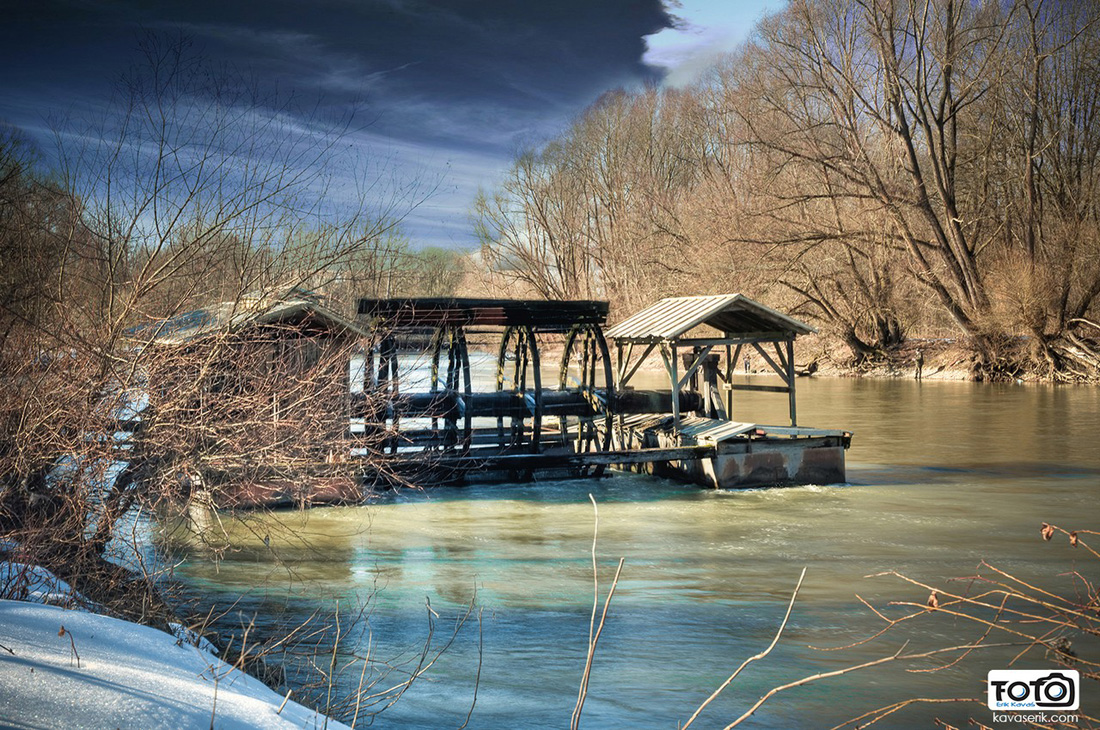Hayrack in a cold moonlit landscape, painting by Vida Fakin. More on Vida.
sustainable croplands
Continuing our series on the culinary delights of that most wonderful of plant families, the cabbages.
Paula Pongrac sends this recipe from Prekmurje, Slovenia – Slaughtered turnips. And just below is a photo from the region by Erik Kavaš.
“No, I am not suggesting taking the biggest knife you have and attack the turnip! Rather I want to tell you about another delicious way to prepare turnip (especially in winter time as it is a real winter-warmer) and of when this dish was typically consumed in Prekmurje, eastern part of Slovenia.

“The name may suggest that Slaughtered Turnip (“Bujta repa” in the Slovenian dialect of Prekmurje) was, and of course still is, a dish prepared when slaughter takes place (typically of pigs). It is essentially a stew with pork, fermented turnips and millet grain, but believe me, this is an experience to remember.
“Unfortunately, it is not easy to get hold of fermented turnips outside Slovenia, but there are some relatively easy recipes for home-fermentation of vegetables available on-line (search term “turnip kraut” yields good results, although the term is clearly wrong as it means “turnip cabbage”) or just decide on visiting Slovenia and have a taste.
“In case you get lucky and you get hold of all the ingredients, this is how you make Slaughtered Turnip.”
1 kg fermented turnip (grated), sometimes referred to as turnip kraut
1 kg pork bones with meat
150 g millet grain (proso millet)
1-2 tablespoons of oil
1-2 tablespoons of flour
One onion
3 garlic cloves
Salt
Red sweet paprika
Black pepper
2 bay leaves
Place the fermented turnip into a big pot with pieces of meat, add some ground and whole black peppers and bay leaves, and cover with cold water. Bring to boil and simmer for 30 – 60 minutes until turnip is tender and the meat is almost done. Then add washed millet grain and some extra water and cook until the millet is no longer crunchy.
For the roux, fry the sliced onion and garlic in oil until onion and garlic turn golden. Add the flour and stir for few seconds, then add some water, bring to boil and cook for 2 minutes. Add red paprika and extra water if needed to keep the roux smooth.
Just before finishing the turnip-meat-millet mixture, add the roux and bring everything to boil. Add salt to taste and serve with blood sausage or other meat, and bread.
For best experience, Slaughtered Turnip should be reheated at least twice.

Paula Pongrac, from Slovenia, is working at the James Hutton Institute in 2016/17.
The slaughtered turnip in the photograph was prepared for this article by family Barbarič from Prekmurje. With thanks.
Images of the turnip dish supplied by Zoran Kuzma.
Images of ‘Mill on river Mura in Prekmurje’ and ‘Field of gladiols in Prekmurje’ supplied by photographer Erik Kavaš.
The millet used in the recipe is dehulled proso millet, known as ‘proso groats’. Dehulling takes the protective covering off the grain to make it more edible in stews (as pearl barley).
Link to Paula’s other turnip recipe: Turnip strudel – a Croatian version
For the turnip’s close relative, the swede or neeps: SoScotchBonnet and the painting Neep by by Jean Duncan;.
Nocni dialog, oil, 1964 by Vida Fakin. More on Vida ….
Slovenian countryside, hay-racks, the artist Vida Fakin
Travelling through the countryside of Slovenia, through the intimate patchwork of fields and enclosures, attention is repeatedly drawn to the hay-racks that stand sometimes isolated in pasture and sometimes clustered around farmsteads.
 These hay racks embody a very direct and very local chain from soil to plant to beast to field. Hay is cut from meadows and grassy places, collected and hung over horizontal wooden poles to dry, then fed to farm animals when the natural pasture is out of season.
These hay racks embody a very direct and very local chain from soil to plant to beast to field. Hay is cut from meadows and grassy places, collected and hung over horizontal wooden poles to dry, then fed to farm animals when the natural pasture is out of season.
The hay-racks take on a range of forms, from two simple concrete posts spanned by a corrugated iron roofing strip to two-storied structures having the wooden poles along the side, rooms above, partly open at least on one side, and a place below for farm machinery (images below).
So it was good fortune to meet the daughter (Mojca Suklje) and granddaughter (Helena Suklje) of the artist Vida Fakin whose interests, among many, were the ikons of the Slovenia countryside and in particular its hay-racks and scarecrows set against a backdrop of mountain pasture and rocky hills.
And it was even better when Mojca and Helena agreed to provide material about Vida and her art for the Living Field web site.
We will begin with the notes for an exhibition of Vida Fakin’s works held in 2015 at the Josef Stefan Institute Ljubljana.

The black and white images above were taken by the editor in the Bohinj area of Slovenia, around Studor and on higher pasture.
The image at the top of the page is the front cover of Monografija / Vida Fakin – Ljubljana: Enotnost 1994.
Living Field page on Vida Fakin. Also More than landscape and Hay-racks.